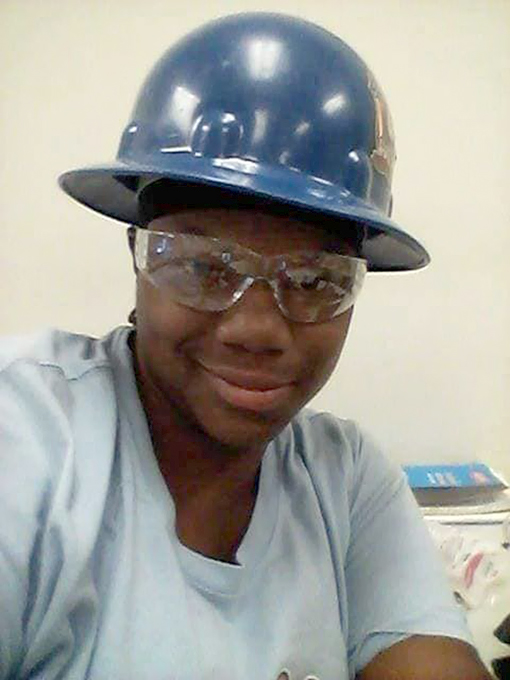A Sister’s Murder Sparks Action – Tradeswomen Respond to Workplace Violence
By Molly Martin
Carpenter apprentice Outi Hicks was working on a job in Fresno, California in 2017 when she encountered continuing harassment from another worker there. She didn’t complain and no one stood up for her. Then her harasser attacked her and beat her to death.
We don’t know whether Outi (pronounced Ootee) was murdered because she was Black, lesbian, or just female. But we do know that being all three put her at greater risk. Outi was 32 and a mother of three.
Outraged tradeswomen organized Sisters United Against Workplace Violence to provide support, education, and empowerment to women in construction.
Also, in response to Outi’s murder the Ironworkers Union (IW) launched a program called “Be That One Guy”. The program’s aim is to “turn bystanders into upstanders.” Participants learn how to defuse hostile situations and gain the confidence to be able to react when they see harassment.
“Outi Hicks’ murder hit me hard,” says Vicki O’ Leary, the international IW general organizer for safety and diversity. “Companies and unions need to change the focus of their harassment policies and need to get tougher with harassers.”
Often the victim of harassment is moved to a different crew or jobsite in an effort to defuse the situation. But such a response actually punishes the victim and not the aggressor, who remains unaffected and may continue to harass other workers. O’Leary says one of the most important parts of the program is when participants take the pledge: “I will be that one guy who tells a coworker, foreman, or general foreman to knock it off.”
“It only takes one guy to talk to the harasser or to file a complaint with the crew boss. It’s even better when the whole crew stands up together to end harassment, and we are now seeing this happen on job sites around the country,” says O’Leary. She tells of an apprentice who was being harassed by a supervisor. Seeing the harassment, everyone on the crew began to treat the supervisor the same way he was treating the apprentice. His behavior changed in a day.
Training, Risk Assessment, and Support
The IW is rolling out the program through their district councils. They want to share it with other unions and, says O’Leary, they’re hoping general contractors will jump on.
Another anti-violence program started by tradeswomen and our allies also is specifically tailored to the construction industry. ANEW, the pre-apprenticeship training program in Seattle, created its program, RISE Up, to counter the number of people, and especially women, who leave the construction trades because of a hostile work environment. ANEW director, Karen Dove, developed the program after meetings with contractors who would say “women just need tougher skin.”
The program focuses on empowering workers and employers to prevent and respond to workplace violence. It offers a range of services, including training sessions, risk assessments, and support for workers who have experienced violence.
Training sessions are designed to help workers and employers identify the warning signs of workplace violence and take proactive steps to prevent it. The training covers conflict resolution, de-escalation techniques, and the importance of creating a positive work environment.
The program is concerned with psychological well-being and is now working with a union to develop mental health services for Black workers.
RISE Up also offers risk assessments to construction companies, which help them identify areas of their workplace that may be at higher risk of violence.
Marquia Wooten, director of RISE Up, says the program is designed to change the culture of construction. Wooten worked in the trades for ten years as a laborer and an operating engineer. “When I was an apprentice they yelled and screamed at me,” she says. She notes that men suffer from harassment too. “The suicide rate of construction workers is number two after vets and first responders,” she said. “Substance abuse is high in construction.”
ANEW partners with cities, public entities, unions, schools, and employers. “They do want change in the industry,” says Wooten. Less workplace violence is good for the bottom line.
But training workers is not enough. Union staff needs training in how to respond to harassment as well. Liz Skidmore recently retired as Business Representative/Organizer at North Atlantic States Regional Council of Carpenters. They created a training to help union staff members know what to do when a member complains.
“New federal regulations require that every person on the construction job who comes into contact with apprentices go through anti-harassment and discrimination training,” says Skidmore.
“Most of corporate America requires annual training about sexual harassment, but most trainers don’t know the blue-collar world,” she says. Trainers can be classist. “To be effective, the trainer has to like these guys.”
While tradeswomen have long been virtually invisible on the front lines of the Feminist and Civil Rights Movements, we still are the ones who daily confront the most aggressive kind of sexism and racism in our traditionally male jobs. For going on five decades now we have been devising strategies to counter isolation and harassment at work and to increase the numbers of women in the union construction trades. Now we are working to educate the construction industry about how to end workplace violence. Women in construction are still isolated and often the only woman on the job. We need our brothers to act as allies.
Women who have risen into leadership positions in construction unions and apprenticeship programs have changed the culture already–in ways that make the workplace safer for both men and women.
Sometimes you just have to say something.
…
For more information about the Tradeswomen Movement see the National Taskforce on Tradeswomen’s Issues.
